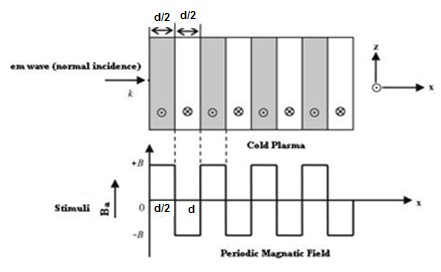Design of Linear Magnetic Field Sensor Based on Periodically Magnetized Cold Plasma
DOI:
https://doi.org/10.61343/jcm.v1i01.4Keywords:
Extrinsic, Magnetized, Magnetic field, Sensor, Reflectance, Cold plasma, Photonic crystalsAbstract
We have analyzed the impact of a linear magnetic field on the photonic band gaps exhibited by bulk cold plasma, under external square-wave-like periodic magnetic field of fixed magnitude, conceived as an extrinsic photonic crystal. Here photonic band gaps are determined using transfer matrix method (TMM). Here, the impact of an additional linear magnetic field is determined on the band gaps of plasma photonic crystal with constant magnitude of square like periodic magnetic field, for normal incidence. We determine how the additional and magnetic magnetic field affects the photonic band structure (PBS) and reflectance for such extrinsic photonic crystal. It is noted that, as we increase the additional applied magnetic field, the central frequency of band gaps is shifted toward higher frequency regions in GHz. The band edge increases linearly with the applied magnetic field. The shifting in lower band edge less as compared to upper edge. Sensor is a device which detect the stimuli and give output, and many physical parameters can be measured by sensors. The shifting of band edges can be utilized in design of magnetic field sensor. Here shifting in band gaps by variation in the additional applied magnetic field are determined. The larger value of sensitivity gives a good result for sensing-based application. This analysis is based on the band gaps of extrinsic photonic crystal, and can be employed in design of magnetic field sensor with good sensitivity. Moreover, it can find applications in tunable optical devices.
References
Joannopoulos, J.D. Johnson, S.G., Winn, J.N., Meade, R.D. Photonic Crystals: Molding the Flow of Light, Second Edition, Princeton University Press, Princeton, 2008.
E. Yablonovitch, Phys. Rev. Lett. 58, 2059, 1987.
S. John, Phys. Rev. Lett. 58, 2486, 1987.
Kumar N. and Rostami A. Novel Features and Perspectives of Photonic Crystals, Lambert Academic Publishing GmbH & Co. KG, Saarbrücken, Germany, 2012.
N. Kumar and S. P. Ojha, Progress In Electromagnetics Research 80, 431, 2008.Development of and Basic Property Research Trends in Environment-friendly Piezoelectric Materials, Tae Kwon Song, Seung Eon Moon, Physics and High Technology, 2013, 22(1/2):2.
H. Hojo and A. Mase, Journal of Plasma and Fusion Research 80, 89, 2004.
L. Qi and X. Zhang, Solid State Communications 151, 1838, 2011.
King, T.C., et al. Physica E, 67, 7, 2015.
R. Kumar. A. S. Kushwaha and S. K. Srivastava, Optik 126 1324.2015.
P. Yeh, Optical Waves in Layered Media, John Wiley & Sons, Singapore, 1991.
N. Kumar, S. Kaliramna, and M. Singh, Design of Cold Plasma Based Ternary Photonic Crystal for Microwave Applications, Silicon Springer Nature, Oct 2021. https://doi.org/10.1007/s12633-021-01405-9.

Downloads
Published
How to Cite
Issue
Section
License

This work is licensed under a Creative Commons Attribution 4.0 International License.
Copyright© by the author(s). Published by journal of Condensed Matter. This is an open access article distributed under the terms of the Creative Commons Attribution (CC BY) license (https://creativecommons.org/licenses/by/4.0/), which permits unrestricted use, distribution, and reproduction in any medium, provided the original author(s) and source are credited.









